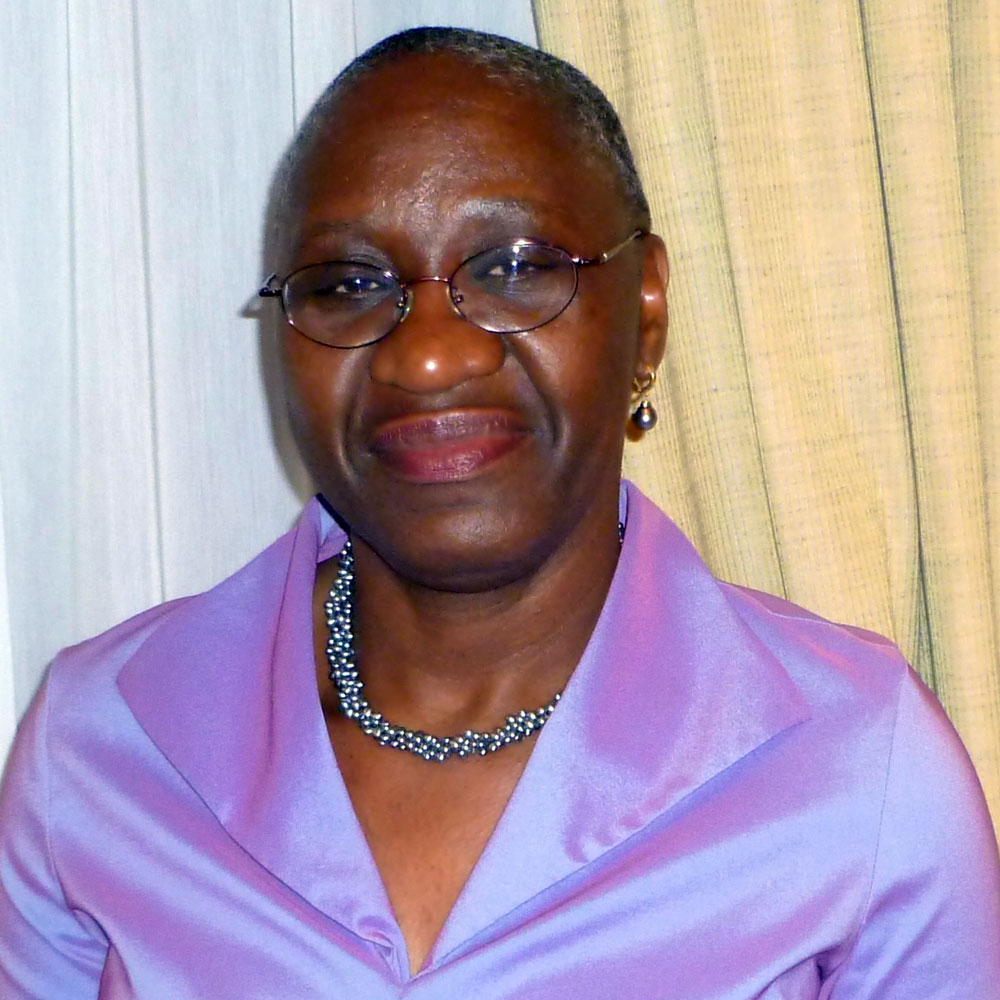Message from the Associate Dean, Division of Nursing Science, to our PhD Graduates
Jump to: Nursing Science Graduates | Urban Systems Graduates

Congratulations, PhD graduates. You have just completed one of the most challenging and transformational journeys of your life. Your PhD diploma reflects the fruit of your extraordinary efforts and, at times, excruciating ordeals throughout the program. Your success is also a community accomplishment that is shared with your family, friends, and mentors who supported you throughout the PhD program.
You entered the program with a bit of trepidation about the rigorous program requirements. You are leaving the program transformed into scientists with the knowledge and empirical skills to contribute significantly to society. You are heading into a world complicated by health, social, and political issues, such as a global health pandemic, social injustices, health disparities, and an upcoming presidential election, all of which have important impacts on the health of individuals and the healthcare landscape. As a PhD graduate, you are officially recognized as capable of addressing these challenges through the creation of evidence-based practices, shaping health policy, designing high-quality, patient-centered healthcare systems, and innovative scientific contributions that improve the lives and health of persons around the globe.
The research knowledge and skills you have acquired, your accomplishments in the PhD program, and your dissertation research provide a passport for your new journey as a scientist into a complex world. This journey will require a balance of exploiting what you know and have learned versus exploring new horizons. As far as exploitation, you need to publish your dissertations and other work you have in-progress. There are likely important follow-up studies you have in mind. Conduct studies that build on each other and contribute to your identity as a person who advances our understanding of an important issue or problem. As far as exploration, it is important to find and build your community of scholars who are working on similar interests as yours. You will find this community in various settings such as a formal postdoctoral fellowship, within a faculty in which you have secured an appointment, or in a leadership role in a healthcare setting, industry, professional organization, or health policy field.
As you begin this new chapter in your careers, I encourage you to treasure and maintain the bonds that you have formed with your colleagues and faculty in the School of Nursing and to strengthen and reinforce these networks through our alumni association.
Once again, I offer my sincerest congratulations to all of you. I look forward to reading the interesting research that you will produce and hearing about your successes.
Charlotte Thomas-Hawkins, PhD, RN, FAAN
Interim Associate Dean, Division of Nursing Science, and Associate Professor
PhD in Nursing Science
Class of 2021
Dissertation Defenses

Jamie M. Smith
Among Medicare Beneficiaries Living with Diabetes, Does Post-Acute Home Health Care Use Reduce the Risk of Rehospitalization?
03/31/2021
Chair: Olga F. Jarrín Montaner, Ph.D., R.N.
PhD in Nursing Science
This dissertation was a cohort analysis of Medicare fee-for-service and Medicare Advantage beneficiaries who experienced a diabetes-related hospitalization in 2015 and were discharged home with or without home health services. The study used Medicare administrative, claims, and assessment data (2014-2016) and was informed by Andersen and Newman’s Framework for Viewing Health Services Utilization. The analytic approach included using multivariate logistic regression models to assess for predictors of home health referral and use during the post-acute period. Multivariate logistic regression models included patient demographics, clinical, and geographic variables were used to evaluate the relationship between the timing of home health care initiation and 30-day rehospitalizations. Inverse probability weighted propensity scores were incorporated into the analysis to account for potential confounding between the timing of home health care initiation and the outcomes.
Significant research findings include differences in home health referral and initiation. In the fully adjusted models, Hispanic and American Indian/Alaska Native patients were 20% less likely to be referred to home health than white patients (p <0.05). Among patients who received referrals, all racial/ethnic minority patients were less likely to receive home health care within 14-day of hospital discharge. Medicare Advantage and Medicaid Advantage/Medicaid beneficiaries were half as likely to receive services than traditional Medicare patients (p <0.05). A home health visit should be initiated within 48 hours of returning home following hospitalization per the Centers for Medicare and Medicaid’s conditions of participation. Delayed home health initiation was associated with a 28% increase risk (p <0.001), and late initiation was associated with four times increase in odds of rehospitalization (p <0.001). The relationship between the timing of home health initiation and rehospitalization was significant across racial/ethnic groups. Asian American/Pacific Islander and American Indian/Alaska Native patients were most affected by timing; they were 6 to 7 times more likely to be rehospitalized when home health was late (p <0.001).
The study findings suggest systemic disparities in post-acute home health access by race/ethnicity and insurance. Furthermore, the findings provide compelling evidence of home health care services’ value as a strategy to reduce 30-day hospital readmissions among Medicare beneficiaries with diabetes. Future efforts to reduce racial/ethnic disparities in post-acute care outcomes among patients with a diabetes-related hospitalization should include policies and practice guidelines that address structural racism and systemic barriers to accessing prompt home health care services. Future research should use a racial justice lens when exploring relationships among institutional and structural determinants on post-acute services.

Rosario V. Sanchez
The Elopement Process of Adult Survivors of Sex Trafficking during Adolescence
03/11/2021
Chair: Dr. Rula Btoush
PhD in Nursing Science
Results from the multiple case study design uniquely positioned the voices of survivors as experts in expanding knowledge about the elopement process. The results revealed a non-linear process, a Maze, not explored in the literature before. The maze illustrates the elopement process as experienced by the survivors. The maze affords a deeper look to the effects of the barriers to elope for knowledge development in nursing practice, policy and research, and provides insights for a future assessment tool measuring readiness to elope.

Janine Pezzino
Ethnography of Deaf Individuals:
A Struggle with Health
01/19/2021
Chair: Dr. Lucille Eller
PhD in Nursing Science
The research question that this study considered is: How does someone who is Deaf obtain, process, and understand basic health information and use that information to make appropriate health decisions? An ethnographic study was conducted in order to understand health literacy from the perspective of someone who is culturally Deaf. The informed consent was translated into American Sign Language (ASL) and video recorded. Twelve interviews and 75 hours of participant observation were conducted. All interviews took place in a place of privacy with 2 interpreters.
The themes that were identified were: communication, going to the doctor, audism, Deaf culture, family, and privacy. Themes were identified based on observations across interviews and participant observation. Many themes were interrelated. Several implications for future research and practice were noted including how privacy with the Deaf community impacts health literacy, how family dynamics may influence health literacy with the Deaf community and the effect of having an in-person interpreter versus a virtual interpreter during a visit with a health care provider.

CPT (P) Melissa Miller
US Army Primary Care: Nursing Practice Environment, Team Performance, and Outcomes
08/20/2020
Chair: Mary L. Johansen
PhD in Nursing Science
Hypotheses: This study tested three hypotheses: (a) the nursing practice environment is positively associated with team performance, clinic staff perception of overall patient safety, and staff nurse job satisfaction, and negatively associated with staff nurse intent to leave, (b) team performance is positively associated with clinic staff perception of overall patient safety and staff nurse job satisfaction, and negatively associated with staff nurse intent to leave, and (c) team performance mediates the relationship between the nursing practice environment and clinic staff perception of overall patient safety, staff nurse job satisfaction, and staff nurse intent to leave.
Method: This is a cross-sectional, correlational study examining secondary data from 2016 representing 39 US Army primary care clinics located in eighteen states and Germany.
Purpose:The purpose of this study is to examine the relationships among the nursing practice environment, team performance, clinic staff perception of overall patient safety, staff nurse job satisfaction, and staff nurse intent to leave in US Army primary care clinics.
Findings: The findings of this study highlight the importance of a positive nursing practice environment, especially nurse manager ability, leadership, and support for nurses to clinic and staff nurse outcomes including intent to leave as an indicator of attrition.
Key words: nursing practice environment, team performance, patient safety, job satisfaction, intent to leave
Disclosure: This research project is sponsored by the TriService Nursing Research Program, Uniformed Services University of the Health Sciences; however, the information or content and conclusions do not necessarily represent the official position or policy of, nor should any official endorsement be inferred by, the TriService Nursing Research Program, Uniformed Services University of the Health Sciences, the Department of Defense, or the U.S. Government. The views and information presented are those of the author and do not represent the official position of the U.S. Army Medical Department Center and School Health Readiness Center of Excellence, the U.S. Army Training and Doctrine Command, or the Departments of Army, Department of Defense, or U.S. Government
PhD in Urban Systems / Health Track
Class of 2021
Dissertation Defenses

Nazsa S. Baker
“Nothing seems normal anymore”: A Study of Black Male Firearm Violence Survivors in a Hospital‐based Violence Intervention Program”
4/29/2021
Chair: Sabrina Marie Chase, PhD
PhD in Urban Systems / Health Track
Methodology: This mixed-methods study explored life post-firearm injury among ten African American/Black male firearm violence survivors enrolled in an HVIP. The study was guided by the following research questions: 1. What are the day-to-day experiences of African-American/Black men living with firearm injuries? 1a. How does Felitti’s adverse childhood experiences (ACE) questionnaire align with or depart from the narratives of African-American/Black male firearm violence survivors? 1b. How do survivors conceptualize themselves after being injured? 2. Is the HVIP effective in addressing the risk behaviors of African-American/Black male firearm violence survivors in the program? 2a. How does the program align with or depart from the perceptions and priorities of African American/Black male firearm survivors? 2b. What can this tell us about designing firearm violence interventions? 3. What does the PROMIS-29 questionnaire tell us about urban firearm violence survivors’ experiences recovering from a life-changing encounter? Telephone interviews were conducted with all 10 study participants, who also completed the original Felitti ACES questionnaire and the PROMIS-29. The constant comparative method was used to analyze the qualitative data and SPSS was utilized to analyze the results of the PROMIS-29; Excel was used to analyze the results of the ACEs questionnaire.
Results: Three key themes described how these men’s lives have been significantly impacted post-firearm injury: 1) the experience of disability and the physical injuries that they must live with forever, 2) how masculinity is expressed as injured men perform their respective gender norms and roles and construct social identities, and 3) the profound impact of firearm violence on their mental and emotional health. Analysis also indicated that the HVIP in this study appears to be effective in addressing risk behaviors within this group. Further, study findings showed that Felitti’s ACEs questionnaire departed significantly from participants’ childhood narratives. After analyzing ACE scores and comparing them with participant narratives, it is evident that this questionnaire cannot provide an accurate indication of childhood trauma in this group. Analysis of the PROMIS-29 yielded inconclusive results.
Conclusion: These findings make it clear that living with firearm injuries affects African American/Black men in every respect, taking a profound toll on their self-esteem and self-image, and leaving them at great risk of feeling diminished as human beings. It also highlights the importance of discharge planning for survivors, especially if they are returning to the same communities in which they were victimized. Finally, these results underscore the importance of listening to the stories of firearm violence survivors in order to fully incorporate their priorities into HVIPs and other interventions.

Jeannie Garmon
There are Layers to This: A Social Ecological Examination of Social Relationships and Health
4/22/2021
Chair: Sabrina Marie Chase, PhD
PhD in Urban Systems / Health Track
Methods: This secondary data analysis utilized data collected through two community health needs assessments (CHNAs) conducted in five southern New Jersey counties (Burlington, Camden, Cumberland, Gloucester, and Salem) between 2018 and 2019. Holt-Lunstad’s 2018 adaptation of the social ecological model was applied to these data to examine how three levels of the social system—the individual, relationship, and community—interact to affect health. Multivariate regression analyses were uses to test hypotheses 1, 2, and 3. Interaction effects regression models were used to test hypotheses 4 and 5.
Results: The final sample size included 1380 respondents. Participants were predominately non-Hispanic/Latino white (n=1082, 78.4%) and female (n=1121, 81.2%), with a mean age of 48.6 years (SD=15.34). More than half (n=767, 55.6%) reported a household income of at least $70,000. A quarter (n=345) had attained a master’s degree or higher. Most respondents were employed; 63.7% (n=879) reported having full-time employment and 79% (n=1090) were employed at least part time. Loneliness, ACE score, and perceived neighborhood connection were each found to have a statistically significant relationship with physical as well as mental health, after controlling for the sociodemographic variables and sleep. Multiple moderation analyses of the effect of ACEs on health by loneliness and perceived neighborhood connection found that the interaction between loneliness and ACEs was significant, but the interaction between ACEs and perceived neighborhood connection with physical health as the outcome variable was not; neither interaction was significant with mental health as the outcome variable. Finally, perceived neighborhood connection was found to moderate the relationship between loneliness score and physical health, but not the relationship between loneliness score and mental health.
Conclusion: The 2018 social ecological model as adapted by Holt-Lunstad offers a useful public health framework for exploration of the relationships between social relationships and health. Use of the adapted model can guide the development of future research aimed at understanding the different levels of the social system as well as the generation of interventions to address those crosscutting issues that emerge. Further research is needed to develop a deeper understanding of the health impacts of interactions between loneliness, ACEs, and perceived neighborhood connection with the goal of developing successful interventions to address their potential health effects.

Lisa B. Dunn
The Social Production of Inequity: An Exploration of Resident Stress and Neighborhood Change in Jersey City
3/29/2021
Chair: Sabrina Marie Chase, PhD
PhD in Urban Systems / Health Track
Methodology: A multi-method qualitative single-case study design was chosen for the study. Twenty-one semi-structured interviews were conducted with Berry Hill residents. Residents were categorized by length of residency including less than three years, three years and up (not lifelong), and lifelong. Study participants were asked about their perspectives regarding life in the Berry Hill neighborhood. History, social reproduction, gentrification, stress and allostatic load, and public policy/embedded procedures. The research questions are:
1. How does Jersey City’s history of displacement relate to current inequities?
2a. To what extent is property revaluation viewed as a form of gentrification by Berry Hill residents?
2b. How do residents view development projects in the Berry Hill neighborhood related to their own housing security?
2c. What opinions do residents hold about changes in neighborhood demographics?
3a. What types of significant experiences do Berry Hill residents identify across their lifetimes related to living in the neighborhood?
3b.Do residents view any/all of these experiences as stressors?
4a property revaluation impacted Berry Hill residents? and
4b. Do residents identify any other public policies that they feel contribute to stress in their lives, or to covert racism in the neighborhood?
Results: Four themes emerged from the research study. These include, “A Forgotten Neighborhood”, “Everyday Life”, “Blatant Racism & Oppression”, and “Physical & Mental Health”. These themes convey resident stressors and their implications, as perceived by residents.
Conclusion: The study concludes that the Berry Hill neighborhood is in a state of mixing which puts longtime residents at risk. A culmination of historic stressors, in addition to the displacement of longtime neighborhood residents increases the risk of physical and mental health issues. Despite cumulative stress, residents display great agency in creating systems and supports within the community. Future research is needed to explore additional contributors on housing stability and segregation, as well as more detailed connections to physical and mental health outcomes among longtime residents.

Frank Giannelli
A Longitudinal Study of Pre-Physician Assistant Life Experiences as Predictors of Working in Primary Care
2/17/2021
Chair: Peijia Zha, PhD
PhD in Urban Systems / Health Track

Constance Kozachek
Factors that Influence Health Behaviors Among Middle Eastern College Women in the United States
11/20/2020
Chair: Rula Btoush, PhD, RN
PhD in Urban Systems / Health Track
Middle Easterners are one of the fastest growing immigrant groups in America, from fewer than 200,000 in 1970 to nearly 1.5 million in the year 2000 (Camarota, 2002). Despite the Middle Eastern population growth in the US and in New Jersey, little is known about the Middle Eastern community; more specifically little is known about Middle Eastern college women in the United States. Therefore, the purpose of this study is to examine the rates and correlates of health behaviors among Middle Eastern college women in the United States.
Methodology: This study was guided by an integrative conceptual framework that drew from two conceptual models and one theoretical model with constructs that are embedded into the four research questions. This integrative approach considers the individual factors within a broader social and community context. The model incorporates the multi-level domains from the Social Ecological Model regarding individual, interpersonal, organizational, and community factors that influence health behaviors within the target population. Acculturation Model is integrated in the framework to address the influence of acculturation and assimilation on health behaviors. The Health Belief Model theorizes the likelihood that an individual will seek preventive care, screening, or adhere to a prescribed health related regimen in the presence of perceived individual beliefs toward experiencing illness/disease.
This descriptive correlational study examined the rates and correlates of health behaviors among Middle Eastern college women in the United States. The study answered the following research questions:
1. What is the prevalence of health behaviors (smoking, cervical cancer screening, age appropriate immunizations, sexual behaviors, nutrition, physical activity, and experiences of unwanted sexual contact and injury) among Middle Eastern college women in the United States?
2. Is there an association between health behaviors and demographic characteristics (e.g., age, marital status, immigration generation status, religious affiliation, etc.) among Middle Eastern college women in the United States?
3. Is there an association between health behaviors and sociocultural factors (e.g. social support, perceived discrimination, religiosity, acculturation, and patriarchal beliefs) among Middle Eastern college women in the United States?
4. Is there an association between health behaviors and access to services (e.g. having a healthcare provider, health insurance, and access to health information) among Middle Eastern college women in the United States?
This study included 406 adult women. A power sample analysis was performed to determine sample size. This study included adult college women ages 18 years and above, whom self-identified as Middle Eastern of Arabic background, due to similar linguistics and conservative culture. This included women from Middle Eastern Arabic countries, including Bahrain, Egypt, Iraq, Jordan, Kuwait, Lebanon, Oman, Palestine, Qatar, Saudi Arabia, Syria, United American Emirates, and Yemen. Eligibility criteria also included immigrant generation status (first or second generation immigrant or on a student visa) and identifying oneself as a current college.
This researcher collaborated with a core group of Middle Eastern college students to navigate Middle Eastern/Arabic cultural, religious, and social events in New Brunswick, Newark, and Paterson, New Jersey. Their presence increased the credibility of this researcher and the research study. This approach to target groups of Middle Eastern women with a cultural navigator opened opportunities to recruit study participants. The study advertisement contained study title, eligibility information, an electronic link to the survey, and QR Scanner, which enabled study participants to access the survey on a mobile device. The on-line survey was posted on REDCap, research data capturing software supported by Rutgers University, for secure access and completion.
Analysis: SPSS (Statistical Package for the Social Sciences) was used for the statistical analysis of the study data. The statistical analysis tested the hypothesis and built predictive models of factors associated with health behaviors among Middle Eastern college women. The analysis proceeded in three stages. The first stage consisted of descriptive (univariate) analysis. The categorical study items were summarized using frequencies and proportions. The second stage consisted of bivariate analysis. Chi-square was used to examine the effect of the categorical predictors on health behaviors. The t-test was used to examine the effect of the continuous predictors on health behaviors.
The third stage consisted of hierarchical multivariate regression analysis, which built models of the predictors (demographics, sociocultural factors, and access to services) for health behaviors (smoking, cervical cancer screening, age-appropriate immunizations, sexual behaviors, nutrition, physical activity, and experiences of unwanted sexual contact and injury). Predictors that were found significant in the bivariate analysis at p < 0.05 were included the multivariate analysis.
Results: The benefits derived from the study findings have provided us with implications to policy, practice, and future research. The study design, integrative theoretical model, and findings contribute to the current literature, which is lacking in data related to factors that influence health behaviors among Middle Eastern college women in he United States.
The study findings provided great insight into the health behaviors and risk factors among Middle Eastern college women. Further, the findings address the factors that influence health behavior in this population, including individual, sociocultural, and access to healthcare factors. Despite the limitations, the findings highlight many opportunities to improve the health of Middle Eastern college women in the US, an under-represented population in research and targeted health interventions. The driving points from this study will inform the expansion of university health service’s policies and primary care to address health services specific to this population. This study provides policy implications for program intervention needed for this population through allocation of resources for risky health behaviors. Policy will influence practice. Within college and university settings, the targets are Student Life Services, which include, recreational centers, food services, student health centers, student organizations, e.g. cultural and religious organizations. Practice is not limited to college and university settings. Program interventions should extend to the community and adjacent neighborhoods. Community settings include community health centers, women’s health centers, private practices, and cultural and religious organizations.
Strategies to promote services should begin with educating providers and services within and around the college or university settings of the unique cultural needs of this population, to include targeted interventions to the more conservative group of Middle Eastern women. Targeting the more conservative women within this population is an opportunity to provide education regarding cervical cancer screening, HPV vaccines, contraception, and experiences of unwanted sexual contact.
Qualitative research based upon the findings from this study would strengthen the data to further understand the mechanism of influence the predictors have on the health behaviors that could help us fine-tune interventions. Furthermore, exploring the diversity within this target population regarding religious affiliations and cultural norms will contribute to the depth of understanding health behaviors within this population.

Paulette E. Forbes
Young Adults with Sickle Cell Disease in Pediatric Care: Crisis in Transitioning to Adult Care
11/12/2020
Chair: Sabrina Marie Chase, PhD
PhD in Urban Systems / Health Track
Objective: This mixed-methods study explored the transition experiences of young adults with SCD from the perspectives of both young SCD patients and health care providers. It was guided by the following research questions: (1) What are the individual, provider and system-level factors that young SCD patients perceive as facilitating and/or impeding transition from the pediatric to the adult health care system? (2) Are young adults with SCD being prepared to access and navigate the adult health care system? (3) What are health care providers’ perceptions of the patient, provider and system-level factors that impact transition? (4) How and when should transition from pediatric to adult health care services begin?
Methods: The study included both qualitative and quantitative components. Sixteen young adults with SCD ranging from 18 to 30 years of age were interviewed using a semi-structured interview guide. Content analysis was utilized to generate codes and identify themes. Additionally, a 16-question web-based survey was administered to 38 health care providers (including nurses, physicians and nurse practitioners) from the pediatric hematology, adult hematology and pediatric and adult emergency departments.
Results: Young SCD patients were very satisfied with the care they received in the pediatric health care system. During interviews, they described developing trusting relationships with pediatric providers and non-clinical team members who were easily accessed during emergencies of all kinds. They also reported fear of leaving pediatrics, minimal or no preparation for the adult health care system, long waits for adult hematology appointments and being stereotyped as drug seekers during emergency department visits. Although they were satisfied with their health care provider(s) in the adult clinic, their transition to the adult health care system was characterized by a reduced access to regular care as a result of limited clinician office hours, chronic specialist understaffing and the absence of ancillary or support staff. All patient participants reported long time wait times for evaluation and treatment in adult emergency rooms coupled with inadequate pain management. Health care providers who completed the survey identified the same barriers as described by patient participants. Providers acknowledged “excellent clinical care” in the pediatric system and a cluster of barriers in the adult system. These included a lack of adult providers and SCD specialists, failure to prepare young adults for transition and system-level barriers such incompatible electronic medical record platforms that inhibit information sharing.
Conclusion: These findings underscore the necessity of implementing a comprehensive multi-disciplinary transition program to prevent increased morbidity and mortality, decrease emergency department use and improve the quality of life for young adults with SCD who age out of pediatric care.

Denise Anderson
Social Justice in Health: The Patient-Centered Medical Home and Health Disparities
10/02/2020
Chair: Sabrina Marie Chase, PhD
PhD in Urban Systems / Health Track
Methodology: Guided by a constructivist perspective, this study utilized a convergent parallel mixed-methods design to examine the efficacy of the PCMH model in reducing health disparities in FQHCs. Four research questions were addressed: 1) Does the NCQA PCMH improve physical and mental health among low-income minority populations, particularly patients with diabetes, hypertension, coronary artery disease, obesity, and risk for depression? 2) What has been the patient experience in NCQA PCMH-recognized health centers serving low-income, minority groups in New Jersey? 3) What has been the health center staff experience in NCQA PCMH-recognized health centers serving low-income, minority groups in New Jersey? 4) What has been the health center staff experience in NCQA PCMH-recognized centers in New Jersey regarding burnout? Fifteen NCQA PCMH-recognized New Jersey FQHCs were included in the sample. Quantitative methods were used to examine 2016-2018 Uniform Data System (UDS) data, including quality of care measures for FQHC patients diagnosed with hypertension, diabetes, and coronary artery disease, as well as prevention screenings for obesity and depression. Qualitative content analysis was used to analyze 990 online Google FQHC patient reviews and 295 online Indeed FQHC employee reviews. A hybrid framework was constructed to guide the analysis. The framework aligned key categories from three conceptual models: 1.) the National Institute on Minority Health and Health Disparities Research Framework, 2.) the National Committee on Quality Assurance (NCQA) PCMH 2014 Operational Standards and Guidelines, and 3.) the Maslach Burnout Toolkit for Medical Personnel.
Results: Although there were yearly improvements for most of the quality of care measures in PCMH-recognized FQHCs, none of the gains were significant. Star ratings for online Google patient reviews were mostly negative. An analysis of patient experiences utilizing the hybrid framework yielded mixed results. Patients reported positive experiences regarding insurance coverage, health literacy, and equal access to care regardless of the ability to pay. Patients reported negative experiences regarding treatment preferences, the patient-clinician relationship, same-day appointments, routine and urgent care appointments, and timely clinical advice by telephone. Star ratings for Indeed online employee reviews were mostly positive; however, some employees described symptoms of burnout that aligned with the hybrid framework categories of emotional exhaustion and personal accomplishment.
Conclusion: This study found little evidence that patient health outcomes were significantly improved at PCMH-recognized New Jersey FQHCs. Study findings suggest the need to design a health care delivery model that reduces health disparities. Although New Jersey has adopted progressive public policies that seek to address obstacles to achieving optimal health, more is needed. Future research should examine other health care delivery models for their ability to reduce health disparities and explore the impact of public policies designed to address inequities. Targeted investment in FQHCs may yet yield an equitable and scalable health system that reduces health disparities and works for all regardless of racial, ethnic or socioeconomic status.

Tyshaneka Saffold
Association Between Dating Violence and Pregnancy Prevention Behavior Among U.S. Adolescents: Findings from 2013, 2015, 2017 Youth Risk Behavior Surveys
08/13/2020
Chair: Dr. Peijia Zha
PhD in Urban Systems / Health Track

Veronica Jones
The “S” Factor: Exploring the Relationships among the Superwoman Schema, Stress, and Self-care in Professional Black Women
06/26/2020
Chair: Sabrina Marie Chase, PhD (chair), Rutgers School of Nursing
PhD in Urban Systems / Health Track
Methodology: Guided by the Giscombé Superwoman Schema framework, this study used a mixed-method concurrent nested research design. Twenty-two professional Black women were interviewed about their perceptions of strength, stress, and self-care in their personal and professional lives. Each participant completed a demographic survey, the Perceived Stress Scale (PSS), a self-care assessment, the Brief COPE assessment, and the Giscombé Superwoman Schema questionnaire. Both in-depth interviews and quantitative assessments addressed five research questions: (1) How do professional Black women in Newark define strength?; (2) What are the major sources of stress within this study population?; (3) What self-care and coping practices do professional Black women in Newark utilize?; (4) Is perceived stress score associated with feelings of obligation to help others?; and (5) Is there an association between coping and self-care assessment scores?
Results: Participants defined strength as overcoming adversity, persevering through challenges, exhibiting resilience, and achieving goals successfully. Despite mixed responses regarding the utility of the Superwoman label, study participants moderately identified (Mean=56.27, SD = 16.17) with the five domains of the Giscombè Superwoman Schema. Study participants exhibited high levels of perceived stress, with a mean score of 31.5. While participants reported high levels of perceived stress, they implemented a variety of problem-focused coping strategies, including active coping, planning, engagement in faith-based activities, and positive reframing. Almost three-fourths of the sample (n=16) reported not using/knowing of available self-care resources in Newark. Non-parametric tests using Spearman’s Rho coefficient was calculated to determine correlations between perceived stress and alldomains of the Giscombé Superwoman Schema. There was no statistically significant association between the PSS and the “obligation to help others” domain (r = .006; p = .789). No association could be identified between coping and self-care assessment scores. However, data collected from the self-care assessment was useful for understanding trends in self-care activities.
Conclusion: This study has important implications for enhancing strategies to support professional Black women. Study results highlight the necessity of developing self-care and stress management programs that prevent or delay chronic disease among this subset of Black women. Study participants voiced the need for opportunities to connect with other women dealing with similar work and life challenges. Study results also led to the development of the “S” Factor Model, which illustrates how professional Black women in this study attempted to cope with the multiple stressors that shape physical and psychological health outcomes. Future research is needed to explore the application of this model among professional Black women throughout the United States.
